初中英语反义疑问句详细讲解
初中英语反义疑问句的用法归纳
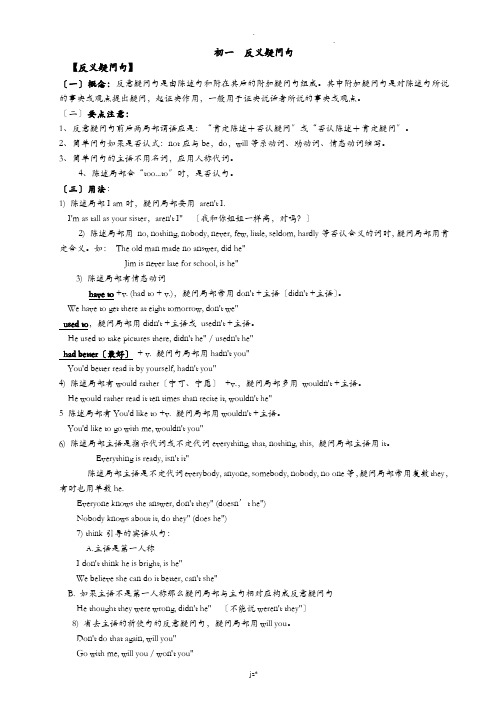
初一反义疑问句【反义疑问句】〔一〕概念:反意疑问句是由陈述句和附在其后的附加疑问句组成。
其中附加疑问句是对陈述句所说的事实或观点提出疑问,起证实作用,一般用于证实说话者所说的事实或观点。
〔二〕要点注意:1、反意疑问句前后两局部谓语应是:“肯定陈述+否认疑问〞或“否认陈述+肯定疑问〞。
2、简单问句如果是否认式:not应与be,do,will等系动词、助动词、情态动词缩写。
3、简单问句的主语不用名词,应用人称代词。
4、陈述局部含“too...to〞时,是否认句。
〔三〕用法:1) 陈述局部I am时,疑问局部要用aren't I.I'm as tall as your sister,aren't I" 〔我和你姐姐一样高,对吗?〕2) 陈述局部用no, nothing, nobody, never, few, little, seldom, hardly等否认含义的词时,疑问局部用肯定含义。
如:The old man made no answer, did he"Jim is never late for school, is he"3) 陈述局部有情态动词have to +v. (had to + v.),疑问局部常用don't +主语〔didn't +主语〕。
We have to get there at eight tomorrow, don't we"used to,疑问局部用didn't +主语或usedn't +主语。
He used to take pictures there, didn't he" / usedn't he"had better〔最好〕+ v. 疑问句局部用hadn't you"You'd better read it by yourself, hadn't you"4) 陈述局部有would rather〔宁可、宁愿〕+v.,疑问局部多用wouldn't +主语。
九年级反义疑问句知识点
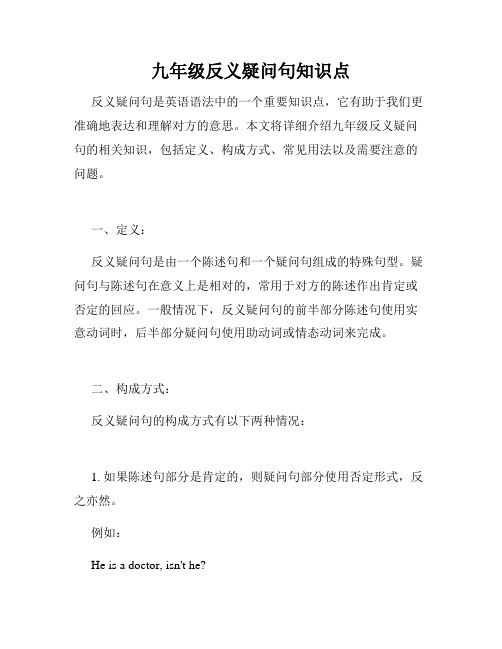
九年级反义疑问句知识点反义疑问句是英语语法中的一个重要知识点,它有助于我们更准确地表达和理解对方的意思。
本文将详细介绍九年级反义疑问句的相关知识,包括定义、构成方式、常见用法以及需要注意的问题。
一、定义:反义疑问句是由一个陈述句和一个疑问句组成的特殊句型。
疑问句与陈述句在意义上是相对的,常用于对方的陈述作出肯定或否定的回应。
一般情况下,反义疑问句的前半部分陈述句使用实意动词时,后半部分疑问句使用助动词或情态动词来完成。
二、构成方式:反义疑问句的构成方式有以下两种情况:1. 如果陈述句部分是肯定的,则疑问句部分使用否定形式,反之亦然。
例如:He is a doctor, isn't he?He isn't a doctor, is he?2. 如果陈述句部分使用助动词或情态动词,疑问句部分使用主要动词。
例如:You can swim, can't you?You can't swim, can you?三、常见用法:九年级阶段,学生需要掌握反义疑问句的常见用法,以下是一些例子:1. 表示请求或征求对方的意见或确认:You will come to the party, won't you?Let's go for a walk, shall we?2. 表示对方的推测并确认:She is your sister, isn't she?3. 表示对方的意见并征求同意或否定:You don't mind if I sit here, do you?4. 表示对方的实际情况并征求确认:You have finished your homework, haven't you?四、需要注意的问题:在使用反义疑问句时,需要注意以下几个问题:1. 人称和时态的一致性:主语的人称和时态需与疑问句的主语相对应,否则会造成语法错误。
例如:She is a doctor, isn't they?(错误)She is a doctor, isn't she?(正确)2. 答案的选择:对于反义疑问句,回答要根据前半部分陈述句而定。
初中英语反义疑问句的14种特殊用法

初中英语反义疑问句的14种特殊用法一、反意疑问句反意疑问句是由陈述句和附在其后的附加疑问句组成。
其中附加疑问句是对陈述句所说的事实或观点提出疑问,起证实作用,一般用于证实说话者所说的事实或观点。
(表示说话者对某事有一定看法,但又不完全确定,需要对方加以证实。
)翻译为“是吗”二、反意疑问句的回答回答时,事实是肯定的用Yes;若事实是否定的则用No。
三、反意疑问句的特殊情况1.反意疑问句中问句部分的动词与陈述部分的动词在语气上成相反的对应关系,即:肯定+否定?否定+肯定?You can’t do it, can you?你不能做它,是吗?They are very late for the meeting, aren’t they?他们开会迟到了,是吗?2.附加问句的主语应与陈述句的主语保持一致,且只能用人称代词替代。
You come from Beijing, don't you?你来自北京,是不是?3.当陈述句中含有be动词,助动词,或是情态动词时,反问句部分由这些词加上主语人称代词构成:Be动词包括:am, is, are, was, were助动词有:do, does, did, have(用在完成时), has(用在完成时)等情态动词有:can, could, may, might, must, will, would, shall, shouldHe will go home, won’t he?他要回家了,是吗?She doesn’t like to eat popcorn, does she?她不喜欢吃爆米花,是吗?4.have的不同用法,反义疑问句用不同的动词(1)have 表“有”时,反义疑问句谓语动词用have/do都行H e has a new car, doesn’t/hasn’t he?(2)have表“吃,喝,玩,度过,举办”等是,反义疑问句谓语动词用doHe has supper at home every day, doesn’t he?They had a good time in Beijing, didn’t they?(3)have to表“不得不,必须”时,反义疑问句谓语动词用doKite has to help her mother, doesn’t she?(4)had better表“最好”时,反义疑问句谓语动词用hadWe had better go to school at once, hadn't we?(5)have用在完成时中,反义疑问句谓语动词用haveThey have known the matter, haven’t they?5.(1)反意疑问句的陈述部分带有little, few, never, hardly, seldom,nobody, nothing, no one, none, neither等否定意义的词时,问句部分用肯定式。
初中反义疑问句详细讲解

初中反义疑问句详细讲解反义疑问句⼀、英⽂中的反意疑问句。
1、什么是反意疑问句英语中,反意疑问句是由陈述句和附在其后的附加疑问句组成。
其中附加疑问句是对陈述句所说的事实或观点提出疑问,起证实作⽤,⼀般⽤于证实说话者所说的事实或观点。
翻译为“是吗”2.反意疑问句的回答,回答时,如果情况属实,⽤Yes加上反问句的倒装肯定句;若果情况不属实,则⽤No加上反问句的倒装否定句。
例如You were moved by your students, weren’t you?情况属实:Yes, I were.情况不属实:No, I weren’t.⼆、反意疑问句中问句部分的动词与陈述部分的动词在语⽓上成相反的对应关系,即:肯定+否定?否定+肯定?如:①You can’t do it, can you?你不能做它,是吗?②They are very late for the meeting, aren’t they?他们开会迟到了,是吗?三.当陈述句中含有be动词,助动词,或是情态动词时,反问句部分由这些词加上主语⼈称代词构成,Be动词包括:am, is, are, was, were助动词有:do, does, did, have(⽤在完成时), has(⽤在完成时)等情态动词有:can, could, may, might, must, will, would, shall, should例如:She is a lovely girl, isn’t she?她是⼀个可爱的⼥孩,是吗?He will go home, __won’t__ __he__?他要回家了,是吗?She doesn’t l ike to eat popcorn, __does__ _she___?她不喜欢吃爆⽶花,是吗?The baby won’t sleep early, will it?⼩宝宝睡得不早,是吗?注意:①He has supper at home every day,doesn’t’t he? (不能⽤hasn’t he?)他每天在家吃晚饭,是吗?②They have known the matter, haven’t they? (不能⽤don’t they?)他们已经知道那事情了,是吗?四.当陈述句中只含有⾏为动词时,若动词加了s,就⽤does, 若动词为原形,就⽤do,动词为过去式,则⽤did,例如:Your father plays the computer very well, __doesn’t__ ___he _?你⽗亲电脑技术很好,是吗?They look so happy today, _don’t ___ _they___?你今天看起来很⾼兴,是吗?五.反意疑问句的陈述部分带有little, few, never, hardly, seldom,nobody, nothing, barely, scarcely等否定意义的词时,问句部分⽤肯定式。
反义疑问句知识点详解(初中英语专项复习)1
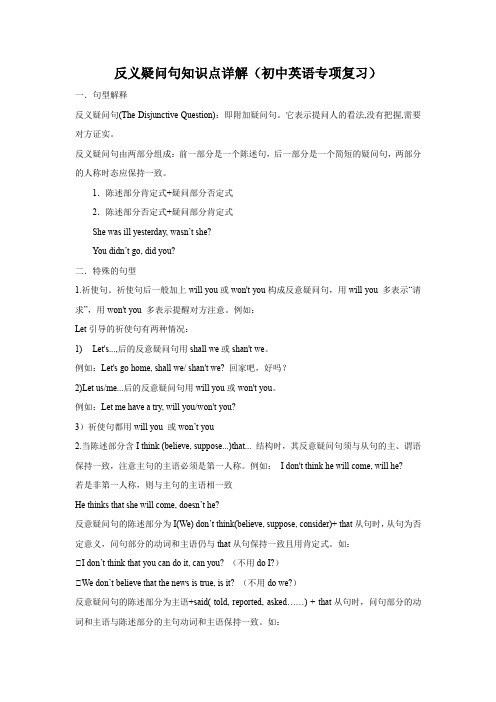
反义疑问句知识点详解(初中英语专项复习)一.句型解释反义疑问句(The Disjunctive Question):即附加疑问句。
它表示提问人的看法,没有把握,需要对方证实。
反义疑问句由两部分组成:前一部分是一个陈述句,后一部分是一个简短的疑问句,两部分的人称时态应保持一致。
1.陈述部分肯定式+疑问部分否定式2.陈述部分否定式+疑问部分肯定式She was ill yesterday, wasn’t she?You didn’t go, did you?二.特殊的句型1.祈使句。
祈使句后一般加上will you或won't you构成反意疑问句,用will you 多表示“请求”,用won't you 多表示提醒对方注意。
例如:Let引导的祈使句有两种情况:1)Let's...,后的反意疑问句用shall we或shan't we。
例如:Let's go home, shall we/ shan't we? 回家吧,好吗?2)Let us/me...后的反意疑问句用will you或won't you。
例如:Let me have a try, will you/won't you?3)祈使句都用will you 或won’t you2.当陈述部分含I think (believe, suppose...)that... 结构时,其反意疑问句须与从句的主、谓语保持一致,注意主句的主语必须是第一人称。
例如:I don't think he will come, will he?若是非第一人称,则与主句的主语相一致He thinks that she will come, doesn’t he?反意疑问句的陈述部分为I(We) don’t think(believe, suppose, consider)+ that从句时,从句为否定意义,问句部分的动词和主语仍与that从句保持一致且用肯定式。
反义疑问句知识点详解(初中英语专项复习)3

反义疑问句知识点详解(初中英语专项复习)一、定义反意疑问句又名附加疑问句。
属疑问句的一种,表示说话者对某事有一定看法,但又不完全确定,需要对方加以证实。
二、结构和原则:1.反意疑问句一般分为两个部分:前一个部分陈述句,后一部分为缩略形式的句问。
如:There is a tree in front of the building, isn’t there?2.反意疑问句遵守前肯后否, 前否后肯, 时态一致性的原则.三、用法:一.反意疑问句主语及谓语的确定.1.陈述部分含有never, few ,little,hardly,seldom,rarely(罕见), no,nothing, nobody, none, too…to 等表示否定意义的词时,其附加问句就用肯定形式.There are few people in the room, are there?She is too young to go to school, is she?2.陈述句部分是“There be…”结构时,疑问部分用“be there”.There is a tree in front of the building, isn’t there?There will not be any trouble, will there?3.陈述部分主语为this, that 等时,附加部分主语应用it.类似地,陈述部分主语为these, those等时,附加部分主语应用they.This is a beautiful picture, isn’t it?Those aren’t apple trees, are they?4.当陈述句部分动词为have(has)时有下列几种情况:(1)have在一般现在时中表示“有”之意,附加问句部分谓语可用“have”或用助动词do.Tom has a new watch, doesn’t he( hasn’t he)?(2) have to表示“不得不”“必须”之意时,附加问句部分谓语应用助动词do.Kate has to help her mother at home, doesn’t she?(3) have 表示“吃、喝、玩、度过”等意时,其附加问句的谓语应用助动词do.They have a good time in Beijing, don’t they?(4)have 在完成时中,其附加问句谓语动词应用have.Lucy has ever been to Japan, hasn’t she?(5) had better 最好,在祈使句中,其附加问句谓语动词应用hadYou had better clean the room,hadn’t you?5.肯定的祈使句的附加问句可用will you或won’t you,否定的祈使句的附加问句用will you.Listen to me carefully, will you?Don’t play with fire, will you?6.以let’s开头的祈使句,附加问句用shall we;而以let us 开头的祈使句,附加问句用will you.Let’s go to the park, shall we?Let us help you, will you?7.think, believe, expect, imagine, suppose等引导的宾语从句:A.主语是第一人称(应特别注意否定的转移)I don’t think he is bright, is he?We believe she can do it better, can’t she?B. 如果主语不是第一人称则疑问部分与主句相对应构成反意疑问句He thought they were wrong, didn’t he?8.否定前缀或后缀(否定前缀dis-, un-, im-或否定后缀-less,如dislike, discourage, unfair, unable等)不能视为否定词,其反意疑问句仍用否定形式。
(完整版)初中英语 反义疑问句的用法归纳

初一反义疑问句【反义疑问句】(一)概念:反意疑问句是由陈述句和附在其后的附加疑问句组成。
其中附加疑问句是对陈述句所说的事实或观点提出疑问,起证实作用,一般用于证实说话者所说的事实或观点。
(二)要点注意:1、反意疑问句前后两部分谓语应是:“肯定陈述+否定疑问”或“否定陈述+肯定疑问”。
2、简略问句如果是否定式:not应与be,do,will等系动词、助动词、情态动词缩写。
3、简略问句的主语不用名词,应用人称代词。
4、陈述部分含“too...to”时,是否定句。
(三)用法:1) 陈述部分I am时,疑问部分要用aren't I.I'm as tall as your sister,aren't I?(我和你姐姐一样高,对吗?)2) 陈述部分用no, nothing, nobody, never, few, little, seldom, hardly等否定含义的词时,疑问部分用肯定含义。
如:The old man made no answer, did he?Jim is never late for school, is he?3) 陈述部分有情态动词have to +v. (had to + v.),疑问部分常用don't +主语(didn't +主语)。
We have to get there at eight tomorrow, don't we?used to,疑问部分用didn't +主语或usedn't +主语。
He used to take pictures there, didn't he? / usedn't he?had better(最好)+ v. 疑问句部分用hadn't you?You'd better read it by yourself, hadn't you?4) 陈述部分有would rather(宁可、宁愿)+v.,疑问部分多用wouldn't +主语。
初中英语反意疑问句的知识点
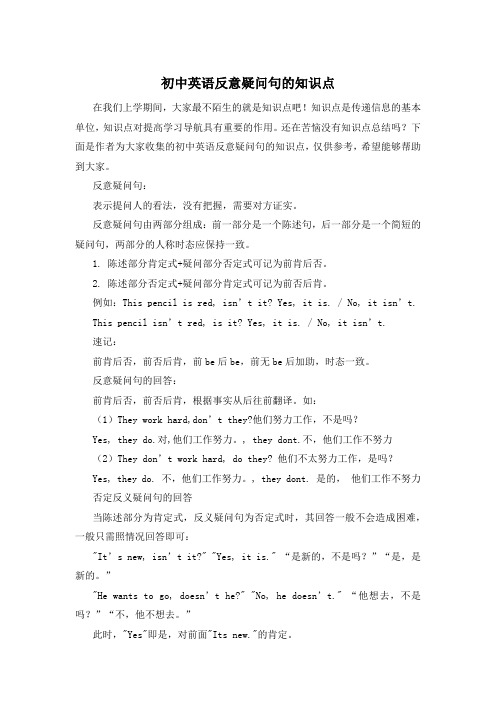
初中英语反意疑问句的知识点在我们上学期间,大家最不陌生的就是知识点吧!知识点是传递信息的基本单位,知识点对提高学习导航具有重要的作用。
还在苦恼没有知识点总结吗?下面是作者为大家收集的初中英语反意疑问句的知识点,仅供参考,希望能够帮助到大家。
反意疑问句:表示提问人的看法,没有把握,需要对方证实。
反意疑问句由两部分组成:前一部分是一个陈述句,后一部分是一个简短的疑问句,两部分的人称时态应保持一致。
1. 陈述部分肯定式+疑问部分否定式可记为前肯后否。
2. 陈述部分否定式+疑问部分肯定式可记为前否后肯。
例如:This pencil is red, isn’t it? Yes, it is. / No, it isn’t.This pencil isn’t red, is it? Yes, it is. / No, it isn’t.速记:前肯后否,前否后肯,前be后be,前无be后加助,时态一致。
反意疑问句的回答:前肯后否,前否后肯,根据事实从后往前翻译。
如:(1)They work hard,don’t they?他们努力工作,不是吗?Yes, they do.对,他们工作努力。
, they dont.不,他们工作不努力(2)They don’t work hard, do they? 他们不太努力工作,是吗?Yes, they do. 不,他们工作努力。
, they dont. 是的,他们工作不努力否定反义疑问句的回答当陈述部分为肯定式,反义疑问句为否定式时,其回答一般不会造成困难,一般只需照情况回答即可:"It’s new, isn’t it?" "Yes, it is." “是新的,不是吗?”“是,是新的。
”"He wants to go, doesn’t he?" "No, he doesn’t." “他想去,不是吗?”“不,他不想去。
(完整)初中英语反义疑问句精讲

反义疑问句反义疑问句(The Disjunctive Question) 即附加疑问句。
它表示提问人的看法,没有把握,需要对方证实。
反义疑问句由两部分组成:前一部分是一个陈述句,后一部分是一个简短的疑问句,两部分的人称时态应保持一致。
主语一般词语附加疑问句中主语用和主语一致的主语,用主格。
不定代词当陈述部分的主语是(1)everyone,no one,nobody 等时,后面的疑问句应表示为:Everyone is in the classroom, aren't they? (基本不用单数,但也可用he)Nobody will go, will they?(2) everything,anything,nothing,something时,附加疑问句中主语一般用it 不用they(3)this,that,或those,these时,附加疑问句中主语用it和they.特殊句型(1)当陈述部分有never,seldom, hardly,few,little,barely, scarcely, nothing 等否定意义的词时,后面的反意疑问句则为肯定形式:There are few apples in the basket, are there?He can hardly swim, can he?They seldom come late, do they?(2)当陈述部分含有否定意思的词是unhappy,dislike,unfriendly等含有否定词缀的派生词,也就是有un-前缀、-less后缀等含有词缀而意思否定的词,当做肯定句处理,疑问部分要用否定形式。
如:He looks unhappy,doesn't he?他看上去不高兴,不是吗?The girl dislikes history,doesn't she?这女孩不喜欢历史,不是吗?含有think, believe, suppose, imagine, expect等动词后接宾语从句构成的主从复合句在构成反意疑问句时,视情况不同有两种不同的构成方式。
英语反义疑问句的问句与回答归纳
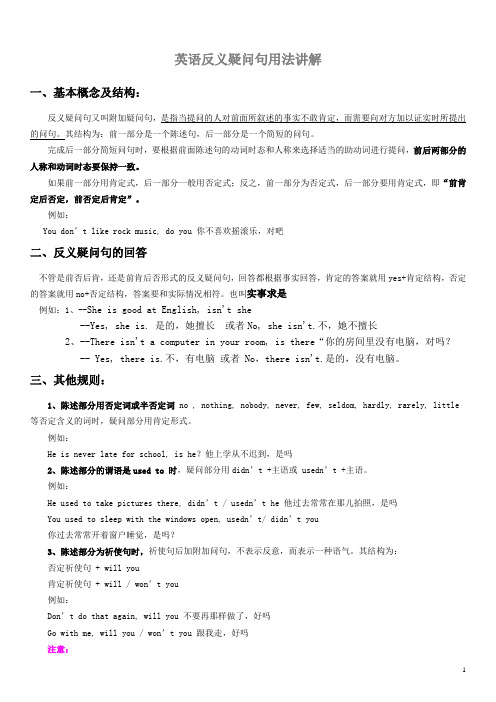
英语反义疑问句用法讲解一、基本概念及结构:反义疑问句又叫附加疑问句,是指当提问的人对前面所叙述的事实不敢肯定,而需要向对方加以证实时所提出的问句。
其结构为:前一部分是一个陈述句,后一部分是一个简短的问句。
完成后一部分简短问句时,要根据前面陈述句的动词时态和人称来选择适当的助动词进行提问,前后两部分的人称和动词时态要保持一致。
如果前一部分用肯定式,后一部分一般用否定式;反之,前一部分为否定式,后一部分要用肯定式,即“前肯定后否定,前否定后肯定”。
例如:You don’t like rock music, do you 你不喜欢摇滚乐,对吧二、反义疑问句的回答不管是前否后肯,还是前肯后否形式的反义疑问句,回答都根据事实回答,肯定的答案就用yes+肯定结构,否定的答案就用no+否定结构,答案要和实际情况相符。
也叫实事求是例如:1、--She is good at English, isn't she--Yes, she is. 是的,她擅长或者No, she isn't.不,她不擅长2、--There isn't a computer in your room, is there“你的房间里没有电脑,对吗?-- Yes, there is.不,有电脑或者 No,there isn't.是的,没有电脑。
三、其他规则:1、陈述部分用否定词或半否定词 no , nothing, nobody, never, few, seldom, hardly, rarely, little 等否定含义的词时,疑问部分用肯定形式。
例如:He is never late for school, is he?他上学从不迟到,是吗2、陈述部分的谓语是used to 时,疑问部分用didn’t +主语或 usedn’t +主语。
例如:He used to take pictures there, didn’t / usedn’t he 他过去常常在那儿拍照,是吗You used to sleep with the windows open, usedn’t/ didn’t you你过去常常开着窗户睡觉,是吗?3、陈述部分为祈使句时,祈使句后加附加问句,不表示反意,而表示一种语气。
反义疑问句的用法归纳及回答举例初中
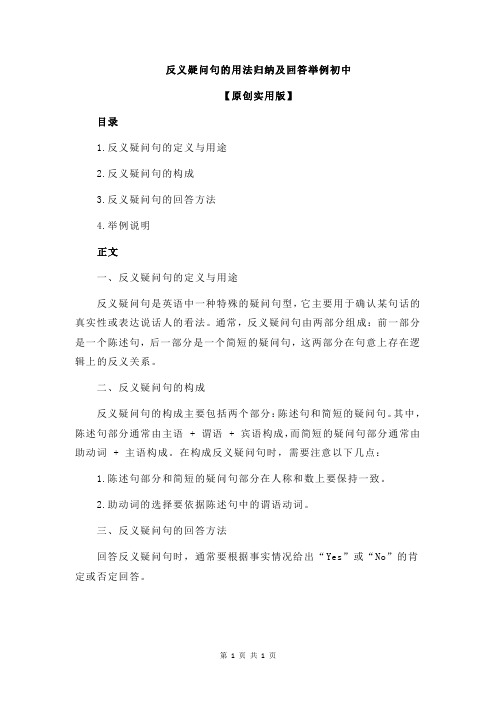
反义疑问句的用法归纳及回答举例初中
【原创实用版】
目录
1.反义疑问句的定义与用途
2.反义疑问句的构成
3.反义疑问句的回答方法
4.举例说明
正文
一、反义疑问句的定义与用途
反义疑问句是英语中一种特殊的疑问句型,它主要用于确认某句话的真实性或表达说话人的看法。
通常,反义疑问句由两部分组成:前一部分是一个陈述句,后一部分是一个简短的疑问句,这两部分在句意上存在逻辑上的反义关系。
二、反义疑问句的构成
反义疑问句的构成主要包括两个部分:陈述句和简短的疑问句。
其中,陈述句部分通常由主语 + 谓语 + 宾语构成,而简短的疑问句部分通常由助动词 + 主语构成。
在构成反义疑问句时,需要注意以下几点:
1.陈述句部分和简短的疑问句部分在人称和数上要保持一致。
2.助动词的选择要依据陈述句中的谓语动词。
三、反义疑问句的回答方法
回答反义疑问句时,通常要根据事实情况给出“Yes”或“No”的肯定或否定回答。
第1页共1页。
初中英语反义疑问句的用法归纳

初一反义疑问句【反义疑问句】〔一〕概念: 反意疑问句是由陈述句和附在其后的附加疑问句组成。
其中附加疑问句是对陈述句所说的事实或观点提出疑问, 起证实作用, 一般用于证实说话者所说的事实或观点。
〔二〕要点注意:1.反意疑问句前后两局部谓语应是: “肯定陈述+否认疑问〞或“否认陈述+肯定疑问〞。
2.简单问句如果是否认式: not应与be, do, will等系动词、助动词、情态动词缩写。
3.简单问句的主语不用名词, 应用人称代词。
4、陈述局部含“too...to〞时, 是否认句。
〔三〕用法:1) 陈述局部I am时, 疑问局部要用aren't I.I'm as tall as your sister, aren't I" 〔我和你姐姐一样高, 对吗?〕2) 陈述局部用no, nothing, nobody, never, few, little, seldom, hardly等否认含义的词时, 疑问局部用肯定含义。
如:The old man made no answer, did he"Jim is never late for school, is he"3) 陈述局部有情态动词have to +v.(had to + v.), 疑问局部常用don't +主语〔didn't +主语〕。
We have to get there at eight tomorrow, don't we"used to, 疑问局部用didn't +主语或usedn't +主语。
He used to take pictures there, didn't he" / usedn't he"had better〔最好〕+ v.疑问句局部用hadn't you"You'd better read it by yourself, hadn't you"4) 陈述局部有would rather〔宁可、宁愿〕+v., 疑问局部多用wouldn't +主语。
初中英语知识点归纳反意疑问句的构成和用法

初中英语知识点归纳反意疑问句的构成和用法反意疑问句是英语中一种特殊的疑问句形式,它由一个陈述句和一个简短的疑问句构成。
它的用法非常广泛,并且在交流中起到了重要的作用。
本文将对初中英语中关于反意疑问句的知识点进行归纳和总结。
一、反意疑问句的构成反意疑问句由一个陈述句和一个简短的疑问句构成。
其中陈述句和疑问句的主谓结构是相反的,即如果陈述句的主语是肯定形式,那么疑问句的主语就是否定形式,反之亦然。
同时,疑问句的谓语动词一般是由陈述句的谓语动词的助动词或情态动词构成。
例如:陈述句:You can swim.疑问句:You can swim, can't you?陈述句:He didn't go to the party.疑问句:He didn't go to the party, did he?二、反意疑问句的用法1. 反意疑问句用于征求对方的同意或确认,常常表达说话人的期望、希望或疑虑等。
例如:You will come to the meeting, won't you?(你会来参加会议的,对吧?)2. 反意疑问句用于提出建议或请求,希望得到对方的回答。
例如:Let's go for a walk, shall we?(我们出去散步吧,好吗?)3. 反意疑问句用于询问对方的意见或看法。
例如:You like the movie, don't you?(你喜欢这部电影,对吗?)4. 反意疑问句也可用于推测或肯定自己的观点,并希望对方表示赞同或不赞同。
例如:It's a beautiful day, isn't it?(今天天气很好,对吧?)You must be tired, aren't you?(你一定很累了,对吗?)三、注意事项在构成和使用反意疑问句时,还需注意以下几个问题:1. 主语一致原则:主语一致原则要求疑问句和陈述句的主语一致,即如果陈述句的主语是第一人称,那么疑问句的主语也应该是第一人称,反之亦然。
初中反义疑问句详解及练习和答案
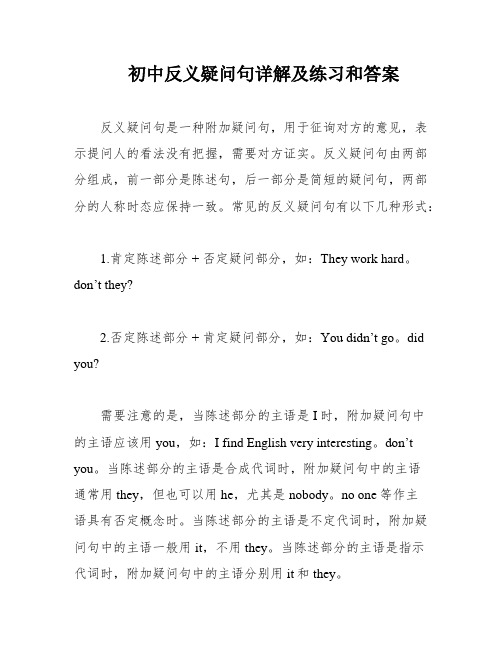
初中反义疑问句详解及练习和答案反义疑问句是一种附加疑问句,用于征询对方的意见,表示提问人的看法没有把握,需要对方证实。
反义疑问句由两部分组成,前一部分是陈述句,后一部分是简短的疑问句,两部分的人称时态应保持一致。
常见的反义疑问句有以下几种形式:1.肯定陈述部分 + 否定疑问部分,如:They work hard。
don’t they?2.否定陈述部分 + 肯定疑问部分,如:You didn’t go。
did you?需要注意的是,当陈述部分的主语是I时,附加疑问句中的主语应该用you,如:I find English very interesting。
don’t you。
当陈述部分的主语是合成代词时,附加疑问句中的主语通常用they,但也可以用he,尤其是nobody。
no one等作主语具有否定概念时。
当陈述部分的主语是不定代词时,附加疑问句中的主语一般用it,不用they。
当陈述部分的主语是指示代词时,附加疑问句中的主语分别用it和they。
5.在正式场合,如果陈述部分以代词one作主语,附加疑问句中的主语也应该用one。
在非正式场合,可以用you或he 代替。
例如:One should always be careful。
shouldn’t one。
或者 can you?One must fulfill his duty。
mustn’t he?6.如果陈述部分用I’m…结构,附加疑问部分一般用aren’t I。
例如:I am feeling good today。
aren’t I?7.当陈述句为there be结构时,附加疑问句中的主语也应该用there。
例如:There’s no way to f ix it。
is there?There’s something strange here。
XXX?8.当陈述部分带有seldom。
hardly。
never。
rarely。
few。
little。
(完整版)初中英语反义疑问句用法归纳
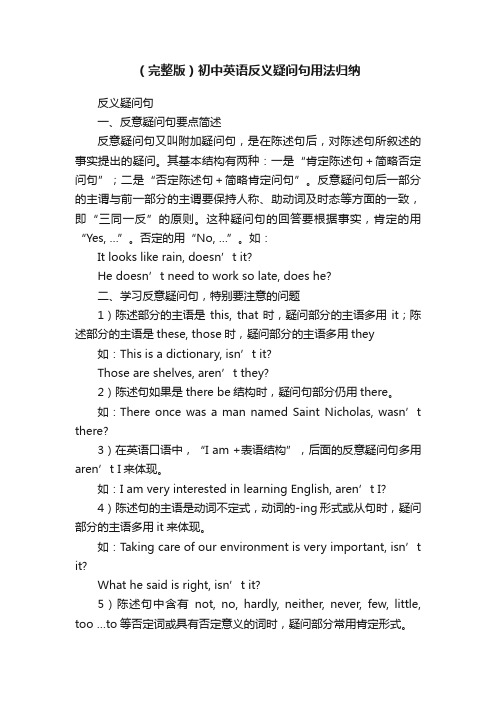
(完整版)初中英语反义疑问句用法归纳反义疑问句一、反意疑问句要点简述反意疑问句又叫附加疑问句,是在陈述句后,对陈述句所叙述的事实提出的疑问。
其基本结构有两种:一是“肯定陈述句+简略否定问句”;二是“否定陈述句+简略肯定问句”。
反意疑问句后一部分的主谓与前一部分的主谓要保持人称、助动词及时态等方面的一致,即“三同一反”的原则。
这种疑问句的回答要根据事实,肯定的用“Yes, …”。
否定的用“No, …”。
如:It looks like rain, doesn’t it?He doesn’t need to work so late, does he?二、学习反意疑问句,特别要注意的问题1)陈述部分的主语是this, that时,疑问部分的主语多用it;陈述部分的主语是these, those时,疑问部分的主语多用they 如:This is a dictionary, isn’t it?Those are shelves, aren’t they?2)陈述句如果是there be结构时,疑问句部分仍用there。
如:There once was a man named Saint Nicholas, wasn’t there?3)在英语口语中,“I am +表语结构”,后面的反意疑问句多用aren’t I来体现。
如:I am very interested in learning English, aren’t I?4)陈述句的主语是动词不定式,动词的-ing形式或从句时,疑问部分的主语多用it来体现。
如:Taking care of our e nvironment is very important, isn’t it?What he said is right, isn’t it?5)陈述句中含有not, no, hardly, neither, never, few, little, too …to等否定词或具有否定意义的词时,疑问部分常用肯定形式。
反义疑问句用法归纳详解

反义疑问句用法归纳详解反义疑问句也叫反义附加疑问句。
它表示提问人的看法,没有把握,需要对方证实。
这一部分的内容在初中英语考试中也是一个常考点,特别是考查学生对疑问句的时态和回答,跟着老师一起来看看初中英语中反意疑问句的14种特殊用法,初中生一定要知道!一、反意疑问句反意疑问句是由陈述句和附在其后的附加疑问句组成。
其中附加疑问句是对陈述句所说的事实或观点提出疑问,起证实作用,一般用于证实说话者所说的事实或观点。
(表示说话者对某事有一定看法,但又不完全确定,需要对方加以证实。
)翻译为“是吗”二、反意疑问句的回答回答时,事实是肯定的用Yes;若事实是否定的则用No。
三、反意疑问句的特殊情况1.反意疑问句中问句部分的动词与陈述部分的动词在语气上成相反的对应关系,即:肯定+否定?否定+肯定?You can’t do it, can you?你不能做它,是吗?They are very late for the meeting, aren’t they?他们开会迟到了,是吗?2.附加问句的主语应与陈述句的主语保持一致,且只能用人称代词替代。
You come from Beijing, don't you?你来自北京,是不是?3.当陈述句中含有be动词,助动词,或是情态动词时,反问句部分由这些词加上主语人称代词构成:Be动词包括:am, is, are, was, were助动词有:do, does, did, have(用在完成时), has(用在完成时)等情态动词有:can, could, may, might, must, will, would, shall, should He will go home, won’t he?他要回家了,是吗?She doesn’t like to eat popcorn, does she?她不喜欢吃爆米花,是吗?4.have的不同用法,反义疑问句用不同的动词(1)have 表“有”时,反义疑问句谓语动词用have/do都行He has a new car, doesn’t/hasn’t he?(2)have表“吃,喝,玩,度过,举办”等是,反义疑问句谓语动词用doHe has supper at home every day, doesn’t he?They had a good time in Beijing, didn’t they?(3)have to表“不得不,必须”时,反义疑问句谓语动词用doKite has to help her mother, doesn’t she?(4)had better表“最好”时,反义疑问句谓语动词用hadWe had better go to school at once, hadn't we?(5)have用在完成时中,反义疑问句谓语动词用haveThey have known the matter, haven’t they?5.(1)反意疑问句的陈述部分带有little, few, never, hardly, seldom,nobody, nothing, no one, none, neither等否定意义的词时,问句部分用肯定式。
- 1、下载文档前请自行甄别文档内容的完整性,平台不提供额外的编辑、内容补充、找答案等附加服务。
- 2、"仅部分预览"的文档,不可在线预览部分如存在完整性等问题,可反馈申请退款(可完整预览的文档不适用该条件!)。
- 3、如文档侵犯您的权益,请联系客服反馈,我们会尽快为您处理(人工客服工作时间:9:00-18:30)。
反义疑问句、英文中的反意疑问句。
1、什么是反意疑问句英语中,反意疑问句是由陈述句和附在其后的附加疑问句组成。
其中附加疑问句是对陈述句所说的事实或观点提出疑问,起证实作用,一般用于证实说话者所说的事实或观点。
(表示说话者对某事有一定看法,但又不完全确定,需要对方加以证实。
)翻译为“是吗”2.反意疑问句的回答,回答时,如果情况属实,用Yes 加上反问句的倒装肯定句;若果情况不属实,则用No 加上反问句的倒装否定句。
例如You were moved by your students, weren 't you?情况属实:Yes, I were. ?was情况不属实:No, I weren 't.注意事项:附加问句的主语应与陈述句的主语保持一致,且只能用人称代词替代。
如:You come from Beijing, don't you? 你来自北京,是不是?The students in Grade One won't go to the park, will they? 一年级的学生不去公园了,是吗?二、反意疑问句中问句部分的动词与陈述部分的动词在语气上成相反的对应关系,即:肯定+ 否定?否定+肯定?如:You can ' t do it, can you? 你不能做它,是吗?They are very late for the meeting, aren ' t they? 他们开会迟到了,是吗?三.当陈述句中含有be 动词,助动词,或是情态动词时,反问句部分由这些词加上主语人称代词构成,Be 动词包括:am, is, are, was, werecan, could, may, might, must, will, would, shall, shoul例如:She is a lovely girl, isn ' t she? 她是一个可爱的女孩,是吗?He will go home, won ' t he? 他要回家了,是吗?She doesn ' t ilke to eat popcorn, does she? 她不喜欢吃爆米花,是吗?The baby won ' t sleep early , will it?小宝宝睡得不早,是吗?注意:He has supper at home every day, doesn 'the? (不能用hasn 't he?)他每天在家吃晚饭,是吗?They have known the matter, haven ' t they? (不能用don 't they?)他们已经知道那事情了,是吗?四.当陈述句中只含有行为动词时,若动词加了s,就用does, 若动词为原形,就用do, 动词为过去式,则用did, 例如:You cleaned your house last week, didn ' t you?你上周打扫了你的房间,是吗?Your father plays the computer very well, doesn ' t he ?你父亲电脑技术很好,是吗?They look so happy today, don 't they?你今天看起来很高兴,是吗?五.(1)反意疑问句的陈述部分带有little, few, never, hardly, seldom ,nobody, nothing, no one, none,neither, barely, scarcely 等否定意义的词时,问句部分用肯定式。
如:① She never tells a lie, does she?(不用doesn 't she?)她从不说谎,是吗?②He was seldom late, was he?(不用wasn 't he?)他几乎不迟到,是吗?3.Nobody phoned while I was out, did they?4.He is hardly able to swim, is he?5.There is little ink in your pen, is there?(2). 含有否定含义的词在陈述部分作动词的宾语时,其反意疑问句用肯定结构,也可以用否定结构。
例如:You got nothing from him, did you? 你从他那儿什么也没得到,是吗?(3) 当陈述部分所含的否定词是通过加前缀或后缀构成的,其后的反意疑问句依然用否定结构。
例如:It is unfair, isn't it? 这不公平,是吧?六、反意疑问句的陈述部分为I am ⋯⋯时,问句部分习惯上用aren 't I?表示。
如:I am a very honest man, aren 't I? 我是个很诚实的人,是吗?七.陈述部分的主语为不定代词something, anything, nothing, everything 时,问句部分的主语用it 。
如:①Something is wrong with the computer, isn ' t it? 电脑有问题了,是吗?②Nothing has happened to them, has it? 他们什么事也没发生,是吗?八、1.陈述部分的主语为不定代词somebody (someone), anybody (anyone), nobody (no one),everybody (everyone) none, neither 时,问句部分的主语用he 或they ,这时问句动词的数应和he 或they 一致。
如:Someone has taken the seat, hasn ' t he? 有人已经坐了位置,是吗?Everyone has done their best in the game, haven ' t they? . 每个人在比赛中已经尽力了,是吗?九.陈述部分的主语是不定代词one 时,反意疑问句的主语可以用one ,也可用you( 美式英语用he) 。
例如:One should be ready to help others, shouldn't one? 每个人都应该乐于助人,是吧?十.陈述部分的主语是指示代词this 或that 时,反意疑问句的主语用it ,当陈述部分的主语是指示代词these 或those 时,其反意疑问句的主语用they 。
例如:This is a plane, isn't it? 这是一架飞机,是吗?These are grapes ,aren't they? 这些是葡萄,是吗?十一.陈述部分为祈使句1 )若为let ' s 引导,反问句用shall we? 例如Let 's go home together, shall we ? 让我们一起回家,好吗?2)若为let us/me 引导和其余的任何一般的否定祈使句,都用will you, 例如Let us stop to rest, will you ? 让我们停下休息,好吗?Don ' t make any noise, will you? 别弄出噪音,好吗?3)一般的肯定祈使句则用will you 或won ' t you 都行,例如:Do sit down, won ' t you?/ will you? 请坐,好吗?You feed the bird today, will you? 今天你喂鸟,是吗?Please open the window, will you? (won ' t you?) 打开窗,好吗?十:陈述部分为There (Here) + be + 主语时,问句部分用动词+there (here)? 形式。
①There are two cakes on the plate, aren 't there? 碟子里有两块蛋糕,是吗?②Here is a story about Mark Twain, isn ' t here? 这是关于马克吐温的故事,是吗?十一. 感叹句。
感叹句后加反意疑问句时,其反意疑问句需用be的一般现在时态的否定形式。
例如:What fine weather, isn't it? 多好的天气啊,是吧?十二. 当陈述部分谓语动词是need, dare, used to ,且这些词被用作实义动词时,其反意疑问句需用do 的适当形式。
若dare 和need 为情态动词,疑问部分用dare 或need 构成。
例如:We need to help them, don 't we?十三. 当陈述部分主语是从句、不定式(短语)、动词-ing 形式时,反意疑问句的主语应该用it 。
例如:What you need is more important, isn't it ?你需要的东西更重要,是吧?十四. 陈述部分有had better 时,反意疑问句中要用hadn't 。
例如:We had better go to school at once, hadn't we? 我们现在最好马上去上学,好吗?18.当陈述部分含有情态动词must 时,我们便要分析一下must 的含义。
如果must 作“一定;要;必须” 讲,反意疑问句须用mustn't 或needn't ;而当must 作推测意义“一定是;必定”讲时,反意疑问句则需根据must 后的动词原形选用相应的形式。
当must 后面接的是完成时是,反意疑问句部分的动词可用haven 't 也可didn 't ( 一般句中有明确的时间状语时用didn ' t) 例如:You must go now, needn 't you ?You mustn 't smoke here, must you?You must have watched that football match last night, didn 't you?19.陈述部分是有and, or, for, but 等引起的并列结构时,疑问部分与邻近分句保持一致。
We must study hard, or we shall fail, shan ' t we?20.陈述部分用neither ⋯nor, not only ⋯but also, 等连接主语时,疑问部分用复数代词。
